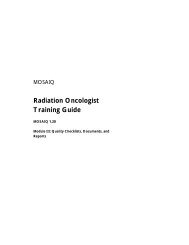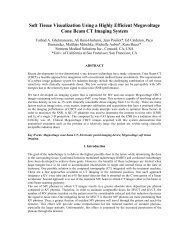Dose-guided radiation therapy with megavoltage cone-beam CT
Dose-guided radiation therapy with megavoltage cone-beam CT
Dose-guided radiation therapy with megavoltage cone-beam CT
Create successful ePaper yourself
Turn your PDF publications into a flip-book with our unique Google optimized e-Paper software.
The British Journal of Radiology, 79 (2006), S87–S98<br />
<strong>Dose</strong>-<strong>guided</strong> <strong>radiation</strong> <strong>therapy</strong> <strong>with</strong> <strong>megavoltage</strong> <strong>cone</strong>-<strong>beam</strong> <strong>CT</strong><br />
J CHEN, PhD, O MORIN, BSc, M AUBIN, Eng-MSc, M K BUCCI, MD, C F CHUANG, PhD and J POULIOT, PhD<br />
UCSF Comprehensive Cancer Center, Department of Radiation Oncology, University of California<br />
San Francisco, 1600 Divisadero Street, Suite H1031, San Francisco, CA 94143, USA<br />
ABSTRA<strong>CT</strong>. Recent advances in fractionated external <strong>beam</strong> <strong>radiation</strong> <strong>therapy</strong> have<br />
increased our ability to deliver <strong>radiation</strong> doses that conform more tightly to the tumour<br />
volume. The steeper dose gradients delivered in these treatments make it increasingly<br />
important to set precisely the positions of the patient and the internal organs. For this<br />
reason, considerable research now focuses on methods using three-dimensional images<br />
of the patient on the treatment table to adapt either the patient position or the<br />
treatment plan, to account for variable organ locations. In this article, we briefly review<br />
the different adaptive methods being explored and discuss a proposed dose-<strong>guided</strong><br />
<strong>radiation</strong> <strong>therapy</strong> strategy that adapts the treatment for future fractions to<br />
compensate for dosimetric errors from past fractions. The main component of this<br />
strategy is a procedure to reconstruct the dose delivered to the patient based on<br />
treatment-time portal images and pre-treatment <strong>megavoltage</strong> <strong>cone</strong>-<strong>beam</strong> computed<br />
tomography (MV CB<strong>CT</strong>) images of the patient. We describe the work to date performed<br />
to develop our dose reconstruction procedure, including the implementation of a MV<br />
CB<strong>CT</strong> system for clinical use, experiments performed to calibrate MV CB<strong>CT</strong> for electron<br />
density and to use the calibrated MV CB<strong>CT</strong> for dose calculations, and the dosimetric<br />
calibration of the portal imager. We also present an example of a reconstructed patient<br />
dose using a preliminary reconstruction program and discuss the technical challenges<br />
that remain to full implementation of dose reconstruction and dose-<strong>guided</strong> <strong>therapy</strong>.<br />
The rationale for adaptive <strong>radiation</strong> <strong>therapy</strong><br />
and dose-<strong>guided</strong> <strong>radiation</strong> <strong>therapy</strong><br />
Recent advances in fractionated external <strong>beam</strong> <strong>radiation</strong><br />
<strong>therapy</strong>, such as three-dimensional conformal and<br />
intensity-modulated <strong>radiation</strong> <strong>therapy</strong> (IMRT), have<br />
increased our ability to deliver <strong>radiation</strong> doses that<br />
conform more tightly to the tumour volume. Clinical<br />
studies and simulations indicate that these more conformal,<br />
higher dose treatments can decrease both the<br />
spread of disease and normal tissue complications [1–5].<br />
Increasing use of functional imaging will also motivate<br />
further complexity in <strong>radiation</strong> treatment plans to<br />
include concurrent boosts in regions of high cancerous<br />
growth [6, 7]. As these dose distributions conform more<br />
tightly to the patient anatomy, dose gradients necessarily<br />
become steeper inside the irradiated volume. Using<br />
IMRT, a dose gradient of 10% mm 21 can be achieved<br />
easily. Thus, it is increasingly important to set precisely<br />
the positions of the patient and the internal organs.<br />
Currently, external markers and patient immobilizing<br />
masks and casts are used to reproduce the skeletal<br />
position of the patient <strong>with</strong> about 3 mm accuracy over<br />
several weeks of treatment [8]. However, the effectiveness<br />
of these alignment and immobilization techniques<br />
are limited by changes in the internal organ locations<br />
relative to bony and external markers. For example, the<br />
prostate can shift up to 1 cm relative to the pelvic bones<br />
due to variations in rectal/bladder filling. During the<br />
course of head and neck cancer treatment, the tumour<br />
This research was supported by Siemens Oncology Care Systems.<br />
Received 30 June 2005<br />
Revised 8 August 2005<br />
Accepted 7 September<br />
2005<br />
DOI: 10.1259/bjr/60612178<br />
’ 2006 The British Institute of<br />
Radiology<br />
can shrink and the patient can lose significant weight,<br />
resulting in dosimetric errors as large as 40% [9, 10]. For<br />
this reason, imaging tools in the treatment room and<br />
methods of adapting treatments to match the patient<br />
anatomy on the treatment table are the keys to realising<br />
the full benefit of conformal <strong>therapy</strong>.<br />
For many decades, imaging inside the treatment room<br />
has played a role in verifying <strong>radiation</strong> <strong>therapy</strong><br />
treatment. Portal images, projection images of the patient<br />
using the treatment aperture, are used to confirm the<br />
patient position and verify coverage of the tumour. The<br />
use of radiographic film for portal imaging has limited<br />
the frequency of this verification due to the required time<br />
and dose to the patient. However, recent implementation<br />
of electronic portal imaging devices (EPIDs) allows a<br />
digital image to be acquired in a few seconds <strong>with</strong> low<br />
doses. This has allowed the use of daily portal imaging to<br />
visualize and adjust the patient position before each<br />
treatment. For example, using implanted gold markers to<br />
locate the prostate, daily portal imaging has been used to<br />
position the prostate <strong>with</strong> 1–2 mm accuracy [11–13]. The<br />
use of portal imaging to adjust patient position before<br />
treatment is limited, however, because soft tissue cannot<br />
be visualized <strong>with</strong>out implanted markers and the full<br />
three-dimensional (3D) geometry is obscured by the<br />
projection onto a two-dimensional (2D) plane. Therefore,<br />
considerable research now focuses on developing threedimensional<br />
imaging of the patient on the treatment<br />
table. Several systems have been developed including<br />
(1) a ‘‘<strong>CT</strong> on rails’’ system, requiring an additional<br />
diagnostic <strong>CT</strong> machine in the treatment room [14]; (2) a<br />
kilovoltage <strong>cone</strong>-<strong>beam</strong> <strong>CT</strong> (kV CB<strong>CT</strong>) system, consisting<br />
The British Journal of Radiology, Special Issue 2006 S87
of an additional kV X-ray source and detector attached to<br />
the treatment gantry [15,16] (these systems are described<br />
more fully in this issue in papers by Thieke et al and<br />
Moore et al, respectively); (3) a <strong>megavoltage</strong> <strong>cone</strong>-<strong>beam</strong><br />
<strong>CT</strong> (MV CB<strong>CT</strong>) system using the pre-existing treatment<br />
machine and EPID for imaging [17–19]; (4) a MV <strong>CT</strong><br />
system, using the pre-existing treatment machine <strong>with</strong><br />
an attached arc of detectors [20]; and (5) a tomo<strong>therapy</strong><br />
system, replacing the traditional treatment machine<br />
(<strong>beam</strong>) <strong>with</strong> a <strong>CT</strong> ring and a MV <strong>beam</strong> source [21–23].<br />
These imaging systems continue to improve and recent<br />
results indicate that 1–2% soft-tissue contrast resolution<br />
is possible [15, 17, 18, 21] as well as accurate localization<br />
of various tumours [14, 16, 19, 20, 22, 23].<br />
In the above examples of image-<strong>guided</strong> <strong>radiation</strong><br />
<strong>therapy</strong> (IGRT), treatment room imaging modalities are<br />
used to translate and rotate the patient to better match<br />
the patient position used for treatment planning.<br />
Another potentially more powerful use of these images<br />
is to modify the delivered treatment fields to account for<br />
the variable patient position. This type of adaptive<br />
<strong>radiation</strong> <strong>therapy</strong> could adjust for the changing relative<br />
positions of the internal organs and the changing shape<br />
of the organs. This is particularly important for organs<br />
that move significantly during the course of treatment.<br />
For these sites, techniques under current development<br />
include gated treatments (halting ir<strong>radiation</strong> when the<br />
target is out of a certain acceptable region) [24–27] or<br />
target tracking during ir<strong>radiation</strong> using specially<br />
designed mobile linear accelerators [28, 29]. For some<br />
sites, however, the most important anatomical changes<br />
occur between treatment fractions. In this case, a pretreatment<br />
image may be used to adjust the treatment<br />
fields immediately before ir<strong>radiation</strong> [30, 31]. Another<br />
possibility is to determine patient-specific anatomical<br />
variation using images from the first week of treatment<br />
and to tailor the treatment plan for future fractions to<br />
account for the individual’s variation [32–34]. Finally, if<br />
the dose that was delivered in previous fractions can be<br />
estimated, the treatment plan for future fractions may be<br />
re-optimized to compensate for dosimetric errors [35].<br />
This dose-<strong>guided</strong> <strong>therapy</strong> could correct for both errors<br />
due to patient anatomical changes as well as machine<br />
delivery errors, thus providing the most accurate dose<br />
delivery. The various adaptive <strong>radiation</strong> <strong>therapy</strong><br />
schemes are depicted in Figure 1.<br />
J Chen, O Morin, M Aubin et al<br />
The development of dosimetric verification<br />
and reconstruction<br />
Currently, few methods are used to track the dose<br />
delivered during treatment. Standard techniques involve<br />
measuring doses on the patient surface using diodes or<br />
thermoluminescent dosemeters. However, these techniques<br />
provide only point dose measurements, and the<br />
time and effort to place the dosemeters on the patient<br />
and process the data limit their clinical use.<br />
Consequently, few institutions use these methods regularly<br />
for treatment verification. A new implantable<br />
MOSFET dosemeter has also been developed [36]. This<br />
dosemeter directly measures the dose in critical internal<br />
structures, but again provides only a point measurement<br />
and is an invasive technique <strong>with</strong> limited application.<br />
What is needed to verify conformal therapies is an<br />
automated method to reconstruct the full 3D dose<br />
distribution.<br />
Several researchers have suggested methods to reconstruct<br />
the delivered patient dose during treatment. Most<br />
methods propose using on-board EPIDs to quickly and<br />
easily acquire a two-dimensional array of digitized X-ray<br />
measurements in a precisely positioned plane in the<br />
treatment exit <strong>beam</strong>. A few formulae have been derived<br />
to estimate the dose to the exit surface, midplane, or centre<br />
point of the patient based solely on EPID measurements<br />
[37–40]. To find a 3D patient dose distribution, however,<br />
requires additional information about the patient position<br />
and attenuation of the <strong>beam</strong>. For breast treatments, a<br />
simple patient contour may give sufficient information<br />
[41]. However, in general, information on tissue inhomogeneity<br />
is also necessary. Several years ago, it was<br />
suggested that the planning <strong>CT</strong> could be used for this<br />
purpose [42, 43], but this method would fail to detect<br />
dosimetric errors produced by the variable patient and<br />
organ positions and shapes. The 3D imaging modalities<br />
that are being developed for IGRT provide an obvious<br />
opportunity to simultaneously obtain the patient geometry<br />
for reconstructing dose. Currently, there is active development<br />
of dose reconstruction procedures for tomo<strong>therapy</strong><br />
systems, and 3% accuracy in low-gradient regions has<br />
been demonstrated [44]. A pilot study using MV CB<strong>CT</strong> on<br />
a traditional treatment machine also found good relative<br />
agreement <strong>with</strong> measurements, but a systematic absolute<br />
deviation [45].<br />
Figure 1. A general view of adaptive<br />
<strong>radiation</strong> <strong>therapy</strong>. The large<br />
grey arrow represents the conventional<br />
flow of treatment, and the<br />
small arrows indicate the possible<br />
points of feedback into the process.<br />
S88 The British Journal of Radiology, Special Issue 2006
<strong>Dose</strong>-<strong>guided</strong> <strong>radiation</strong> <strong>therapy</strong> <strong>with</strong> MV CB<strong>CT</strong><br />
<strong>Dose</strong>-<strong>guided</strong> <strong>radiation</strong> <strong>therapy</strong> using MV CB<strong>CT</strong><br />
and treatment-time portal images<br />
In 2003 [46], we began developing a procedure to<br />
reconstruct the dose delivered to the patient based on<br />
treatment-time portal images and pre-treatment MV<br />
CB<strong>CT</strong>. Our procedure follows the steps described below<br />
and depicted in Figure 2.<br />
Step 1A: Prior to treatment, <strong>with</strong> the patient in the<br />
treatment setup position, acquire a MV CB<strong>CT</strong> image.<br />
This image can be used to align the patient as closely as<br />
possible to the planned position and also provides the<br />
photon attenuation information necessary to reconstruct<br />
the delivered dose.<br />
Step 1B: Convert the MV CB<strong>CT</strong> image to effective<br />
photon attenuation coefficient. Generally, this can be<br />
accomplished by calibrating the MV CB<strong>CT</strong> system using<br />
a calibration phantom composed of materials <strong>with</strong><br />
known electron densities. However, imaging artefacts<br />
in the MV CB<strong>CT</strong> image may need to be corrected to<br />
improve the calibration accuracy.<br />
Step 2A: During the treatment, acquire portal images<br />
of the treatment <strong>beam</strong> as it exits the patient. This portal<br />
image is acquired using the same EPID used for the<br />
CB<strong>CT</strong> imaging.<br />
Step 2B: Convert the portal images to a 2D map of<br />
treatment <strong>beam</strong> energy fluence. The acquired portal image<br />
signal is a convolution of the energy fluence incident on<br />
the detector <strong>with</strong> the detector response to <strong>radiation</strong>.<br />
Moreover, the energy fluence consists of both the primary<br />
<strong>beam</strong> and <strong>radiation</strong> scattered from the patient. To use the<br />
portal image for dose calculations, the primary energy<br />
fluence must be derived from the portal image.<br />
Step 3: Back-project the energy fluence measured at the<br />
detector plane through the CB<strong>CT</strong> of the patient, accounting<br />
for the 1/r 2 falloff of <strong>radiation</strong> from a point source and<br />
attenuation through the patient. This calculation is easily<br />
accomplished if the position of the detector plane relative<br />
to the patient and source is accurately known.<br />
Step 4: Calculate the 3D dose distribution delivered to<br />
the patient using a dose calculation engine. This type of<br />
Figure 2. Overview of proposed<br />
dose reconstruction procedure using<br />
MV CB<strong>CT</strong> imaging and treatmenttime<br />
portal imaging.<br />
The British Journal of Radiology, Special Issue 2006 S89
dose calculation is the same as that performed for<br />
treatment planning purposes, and all the techniques that<br />
have been developed for treatment planning may be<br />
used.<br />
The reconstruction procedure described above provides<br />
an estimate of the 3D dose distribution deposited<br />
in the patient as represented by the MV CB<strong>CT</strong>. Several<br />
uses of the reconstructed dose distribution to guide<br />
future treatments can be envisaged. Scenario 1: The most<br />
basic use of the reconstructed dose is to provide a<br />
dosimetric verification that the treatment delivery generally<br />
provides the desired dose distribution and that no<br />
gross errors exist. This verification could be performed<br />
during the first treatment and repeated weekly throughout<br />
treatment. This simple approach would effectively<br />
reduce gross dosimetric errors, but would not otherwise<br />
increase the precision of the delivered dose. Scenario 2: If<br />
the patient dose is reconstructed for the first week of<br />
treatment, the variation in the delivered dose may also<br />
be evaluated. If the MV CB<strong>CT</strong> for each treatment is<br />
contoured to delineate the various important structures,<br />
the variation in dosimetric indices, such as the maximum<br />
dose to sensitive normal structures or the dose to 95% of<br />
the tumour volume, can be calculated. General systematic<br />
trends such as the under or over dosing of particular<br />
extremities of a structure may also be detected by<br />
examining the dose distributions over the first week.<br />
Based on this information, the treatment plan can be<br />
modified, for example, to increase or decrease margins of<br />
the tumour in particular directions. In this manner, the<br />
treatment plan can be tailored to each individual patient.<br />
Scenario 3: Finally, a complete dose-<strong>guided</strong> <strong>therapy</strong><br />
system would be able to integrate the dose over previous<br />
fractions. This would require the ability to deform the<br />
daily MV CB<strong>CT</strong> images to map identical points in<br />
the patient before the integral dose is calculated [47]. The<br />
cumulative dose distribution can be used to adjust<br />
the treatment plan to compensate for deviations from<br />
the desired distribution, thus improving the accuracy<br />
and conformality of the overall treatment.<br />
The dose reconstruction procedure and the dose<strong>guided</strong><br />
<strong>therapy</strong> described above continue to be developed<br />
and researched. This article summarizes the work<br />
to date and comments on the remaining challenges. First,<br />
we present a description of a MV CB<strong>CT</strong> system that has<br />
been implemented on a linear accelerator for clinical use.<br />
We then describe experiments performed to calibrate the<br />
MV CB<strong>CT</strong> for electron density and to use the calibrated<br />
MV CB<strong>CT</strong> for dose calculations. We also briefly describe<br />
the dosimetric calibration of an EPID for dose reconstruction.<br />
Finally, we present an example of a reconstructed<br />
patient dose using a preliminary reconstruction<br />
program and discuss the technical challenges that<br />
remain to full implementation of dose reconstruction<br />
and dose-<strong>guided</strong> <strong>therapy</strong>.<br />
MV <strong>cone</strong>-<strong>beam</strong> <strong>CT</strong> imaging<br />
MV <strong>cone</strong>-<strong>beam</strong> <strong>CT</strong> imaging is a 3D reconstruction<br />
procedure similar to conventional <strong>CT</strong>. A series of<br />
projection measurements, in this case 2D portal images,<br />
are acquired at many angles around the patient. The<br />
image reconstructed is a 3D image <strong>with</strong>out slice artefacts.<br />
J Chen, O Morin, M Aubin et al<br />
In the <strong>radiation</strong> oncology context, the imaging <strong>beam</strong> is<br />
produced by the conventional linear accelerator used for<br />
treatment, and the projection images are detected using<br />
on-board EPIDs. The imaging photons, therefore, are<br />
primarily in the mega-electron volt energy range. In this<br />
configuration, the patient can be positioned once on the<br />
treatment table and need not be repositioned between<br />
imaging and treatment.<br />
As the linear accelerator gantry and the EPID rotate<br />
about the patient, the EPID and <strong>beam</strong> source positions<br />
will shift from their ideal isocentric locations due to<br />
sagging of the mechanical supports. To correct for this<br />
effect, we perform a geometric calibration of the system,<br />
illustrated in Figure 3 [48, 49]. This calibration provides a<br />
unique relationship between the position of a voxel in<br />
the reconstruction volume and a pixel on the detector<br />
plane for each angle. Because the EPID used for imaging<br />
is also used to detect the exit <strong>beam</strong> fluence, the same<br />
calibration information can be employed during the dose<br />
reconstruction procedure to back-project the energy<br />
Figure 3. Depiction of the geometric calibration of the<br />
linear accelerator/electronic portal imaging device (EPID)<br />
system for <strong>cone</strong> <strong>beam</strong> <strong>CT</strong> (CB<strong>CT</strong>) imaging and for dose<br />
reconstruction. The result of the calibration is a set of<br />
projection matrices (P) that map a point in space (R XYZ) to the<br />
projected point on the detector plane (R uv).<br />
S90 The British Journal of Radiology, Special Issue 2006
<strong>Dose</strong>-<strong>guided</strong> <strong>radiation</strong> <strong>therapy</strong> <strong>with</strong> MV CB<strong>CT</strong><br />
fluence through the MV CB<strong>CT</strong> volume. This prevents<br />
any possibility of misregistration between the EPID<br />
measurements and the MV CB<strong>CT</strong> volume.<br />
The MV CB<strong>CT</strong> system installed in our clinic has been<br />
previously described [19]. Briefly, it consists of an<br />
amorphous-silicon flat panel EPID integrated <strong>with</strong> a<br />
clinical linear accelerator. The total exposure of the CB<strong>CT</strong><br />
acquisition can be varied from 1 to 60 monitor units. Upon<br />
patient selection, a reference <strong>CT</strong> is automatically loaded<br />
into the software. The linear accelerator gantry then rotates<br />
in a continuous 200˚arc acquiring images at 1˚increments.<br />
This acquisition procedure lasts about 45 s. The image<br />
reconstruction starts immediately after the acquisition of<br />
the first portal image, and a 25662566256 reconstruction<br />
volume is completed in 110 s. The software automatically<br />
registers the MV CB<strong>CT</strong> <strong>with</strong> the reference <strong>CT</strong> and<br />
calculates table shifts for patient alignment.<br />
To date, 38 patient MV CB<strong>CT</strong> images have been<br />
acquired in our clinic. All patients have given informed<br />
consent, and the patient image acquisitions are performed<br />
in accordance <strong>with</strong> the institutional review<br />
board’s ethical standards. Depending on the frequency<br />
of the acquisitions, the dose used for MV CB<strong>CT</strong> ranges<br />
from approximately 1.5 cGy to 12 cGy delivered at the<br />
point of rotation (the isocentre). The dose at the entrance<br />
surface of the arc reaches about 160% of the isocentre<br />
dose for an imaged pelvis and 133% for the head and<br />
neck region. The dose at the exit surface falls to about<br />
66% of the isocentre dose for a pelvis and 55% for the<br />
head and neck region. Figure 4 presents four MV CB<strong>CT</strong><br />
images acquired weekly on the same patient to study<br />
tumour evolution. At each new acquisition, the dose was<br />
lowered. The last CB<strong>CT</strong> of the series was acquired <strong>with</strong><br />
approximately 2.9 cGy delivered at the isocentre, still<br />
presenting enough soft-tissue information to assess the<br />
tumour size and perform patient alignment.<br />
Three-dimensional imaging of the patient in the<br />
treatment position exposes the difficulties created by<br />
distortion of patient anatomy. Figure 5 displays the<br />
fusion of a MV CB<strong>CT</strong> image (grey) <strong>with</strong> the planning<br />
<strong>CT</strong> (colour). In this case, a physician has manually<br />
registered the two sets of images by aligning the base of<br />
the skull. A considerable shift, up to 6 mm, can be<br />
observed in the positions of the spinal cord between the<br />
two image sets. This misplacement of the spinal cord<br />
could not be corrected by translating or rotating the MV<br />
CB<strong>CT</strong> image relative to the <strong>CT</strong> as it was caused by an<br />
increase in the arching of the patient’s neck. Although<br />
several fractions would be needed to assess if this<br />
misplacement occurs regularly, the new anatomy, as<br />
depicted by the MV CB<strong>CT</strong> image, could be used to<br />
study the dosimetric impact of the patient’s anatomical<br />
distortion.<br />
MV CB<strong>CT</strong> calibration for dose calculation<br />
To use the MV CB<strong>CT</strong> image in a dose reconstruction<br />
program, the signal from each voxel must be converted<br />
to effective photon attenuation coefficient for the <strong>beam</strong><br />
spectrum (Step 1B of our dose reconstruction procedure).<br />
To perform this conversion, the MV CB<strong>CT</strong> system can be<br />
calibrated using a <strong>CT</strong> calibration phantom (CIRS Model<br />
062, Norfolk, VA) <strong>with</strong> tissue-equivalent inserts, as is<br />
currently done <strong>with</strong> kV <strong>CT</strong>. A table is formed mapping<br />
<strong>CT</strong> signal intensity to electron or physical density which<br />
can then be converted to photon attenuation coefficient<br />
for a known <strong>beam</strong> spectrum. Figure 6 shows the results<br />
of performing this simple calibration on our MV CB<strong>CT</strong><br />
system using the following inserts of relative electron<br />
density <strong>with</strong> respect to water: lung inhale (0.190), lung<br />
exhale (0.489), adipose (0.952), breast (0.976), water (1),<br />
muscle (1.043), liver (1.052), trabecular bone (1.117) and<br />
dense bone (1.512). The relationship between MV CB<strong>CT</strong><br />
signal and electron density is linear. These results are<br />
similar to previous work <strong>with</strong> MV fan-<strong>beam</strong> <strong>CT</strong><br />
performed on a tomo<strong>therapy</strong> unit at 6 MV [50].<br />
Although the above calibration works well for the<br />
narrow <strong>CT</strong> calibration phantom, the MV CB<strong>CT</strong> images of<br />
extended objects exhibit cupping artefacts due to the<br />
influence of scattered <strong>radiation</strong> reaching the EPID.<br />
Figure 7 illustrates this cupping effect on the MV CB<strong>CT</strong><br />
of a large cylinder of water. If uncorrected, this cupping<br />
artefact will also appear in the image converted to<br />
photon attenuation coefficient, leading to errors in the<br />
calculated dose. However, a simulation study using the<br />
large cylinder of water pictured in Figure 7 indicates that<br />
the dosimetric errors in a homogeneous medium<br />
produced by such severe cupping artefacts remain<br />
relatively small, approximately 4% for a single open<br />
field [51]. This suggests that a crude correction of the<br />
cupping artefact in MV CB<strong>CT</strong> images may be sufficient<br />
to obtain acceptable dosimetric accuracy. To test this<br />
hypothesis, the MV CB<strong>CT</strong> of a water cylinder was used<br />
to model the spatial dependence of the cupping artefact.<br />
A spatially dependent correction function was derived<br />
from this cupping model. This correction function was<br />
then applied to the MV CB<strong>CT</strong> of an anthropomorphic<br />
head phantom as a rough correction for the cupping<br />
artefact in the image. After conversion to density using<br />
the MV CB<strong>CT</strong> calibration curve, this image was imported<br />
into a commercial treatment planning system (Philips<br />
Pinnacle, Bothell, WA). The dose calculated using the<br />
MV CB<strong>CT</strong> compared well <strong>with</strong> the dose calculated using<br />
a kV <strong>CT</strong> of the same phantom. Using a gamma index<br />
comparison <strong>with</strong> a 3% dose and 3 mm distance-toagreement<br />
criterion, 98% of calculated dose points fell<br />
<strong>with</strong>in the acceptance criteria.<br />
The above example demonstrates the potential of<br />
using MV CB<strong>CT</strong> images for dose calculations. Besides<br />
using these images for dose reconstruction, using patient<br />
MV CB<strong>CT</strong> images in the treatment planning system, as<br />
performed on the head phantom described above, would<br />
also provide a useful verification. The MV CB<strong>CT</strong><br />
provides a more accurate representation of the patient<br />
on the treatment table. Applying the treatment plan to<br />
the MV CB<strong>CT</strong> would provide a first estimate of the dose<br />
delivered to the patient during treatment. The effects of<br />
modified patient position or anatomy could be evaluated.<br />
However, the <strong>beam</strong> delivery itself could not be<br />
verified <strong>with</strong>out a full dose reconstruction based on<br />
measurements of the treatment <strong>beam</strong>.<br />
Calibration of EPIDs for exit-plane dose<br />
Besides the patient photon attenuation data, the other<br />
necessary piece of information for dose reconstruction is<br />
The British Journal of Radiology, Special Issue 2006 S91
the treatment <strong>beam</strong> energy fluence derived from the<br />
treatment-time portal images (Step 2 of our dose<br />
reconstruction procedure). An intermediate step to<br />
determining the energy fluence is to convert the EPID<br />
image to a measurable form of dose, in our case the dose<br />
in water measured in the detector plane and at a depth of<br />
1.5 cm [52]. The advantage of first calibrating the EPID<br />
against dose in water is that it can be accomplished by<br />
experiments since the dose in a water phantom is easily<br />
measured. The calibration can then be validated by<br />
measurements as well. Moreover, the dose in water can<br />
J Chen, O Morin, M Aubin et al<br />
Figure 4. Examples of <strong>megavoltage</strong> <strong>cone</strong> <strong>beam</strong> <strong>CT</strong> (MV CB<strong>CT</strong>) images at different exposure levels, from 2.9 cGy to 10 cGy.<br />
be more easily converted to energy fluence due to the<br />
great number of water dose deposition models and<br />
algorithms that have already been developed.<br />
To translate the EPID signal to dose in water, we<br />
employ convolution models of dose deposition. The<br />
lateral spread of the dose in the EPID and in the water is<br />
described by empirically derived kernels. Because the<br />
EPID consists of millions of individual pixels, the dose<br />
deposited in each pixel is also multiplied by a spatially<br />
dependent sensitivity factor that accounts for inhomogeneity<br />
in the detector response. Finally, comparisons of<br />
S92 The British Journal of Radiology, Special Issue 2006
<strong>Dose</strong>-<strong>guided</strong> <strong>radiation</strong> <strong>therapy</strong> <strong>with</strong> MV CB<strong>CT</strong><br />
Figure 5. Registration of a patient <strong>megavoltage</strong> <strong>cone</strong> <strong>beam</strong><br />
<strong>CT</strong> (MV CB<strong>CT</strong>) (grey) <strong>with</strong> the kV <strong>CT</strong> (colour) used for<br />
treatment planning. A large difference in the arching of the<br />
neck causes a considerable deviation in the spinal cord<br />
position.<br />
EPID and ion chamber measurements are used to form<br />
conversion tables that translate between the EPID signal<br />
and dose in water.<br />
To test the calibration procedure, EPID images of the<br />
exit <strong>beam</strong> were acquired through a Rando anthropomorphic<br />
head phantom (The Phantom Laboratory,<br />
Salem, NY). The calibrated EPID images were compared<br />
<strong>with</strong> the dose measured using an ion chamber<br />
(Scanditronix-Wellhöfer CC13, Bartlett, TN) scanned in<br />
a water tank (Scanditronix-Wellhöfer blue phantom,<br />
Figure 6. Megavoltage <strong>cone</strong> <strong>beam</strong> <strong>CT</strong> (MV CB<strong>CT</strong>) intensity as<br />
a function of electron density for tissue-equivalent inserts in<br />
a <strong>CT</strong> calibration phantom (pictured in above left).<br />
Bartlett, TN). Figure 8 shows a comparison between the<br />
measured dose at a depth of 1.5 cm of water and the<br />
calibrated EPID signal for a 10 cm square open field.<br />
The EPID signal matches the measured dose to <strong>with</strong>in<br />
2% (2 standard deviations) for the in-field regions<br />
(excluding the penumbra).<br />
A dose reconstruction program<br />
Utilizing some of the work described above, we<br />
performed a preliminary version of the dose reconstruction<br />
procedure on the treatment of a head and neck<br />
patient in our clinic. A MV CB<strong>CT</strong> image was acquired of<br />
the patient set up on the table as for treatment (Step 1A).<br />
The same day, portal images were acquired (Step 2A)<br />
during the patient’s normal course of treatment (6 MV<br />
<strong>beam</strong>, 2 opposed lateral wedged fields and an anterior–<br />
inferior oblique open field). To utilize the MV CB<strong>CT</strong><br />
image in the dose reconstruction program, it must first<br />
be converted to effective photon attenuation coefficient<br />
(Step 1B). For this test case, the MV CB<strong>CT</strong> was converted<br />
to attenuation coefficient using a spatially dependent<br />
calibration that utilizes the kV <strong>CT</strong> patient image as a<br />
reference. This allowed us to reduce the effects of the MV<br />
CB<strong>CT</strong> calibration on the reconstructed dose, thus highlighting<br />
the dosimetric impact of the remaining steps of<br />
the procedure.<br />
To convert the portal images to energy fluence (Step<br />
2B), the portal images were first converted to equivalent<br />
dose in water using the calibration procedure described<br />
above. To infer the energy fluence at the detector plane<br />
from the equivalent dose in water, we used an in-house<br />
dose calculation program that predicts the dose at a<br />
depth of 1.5 cm of water given the energy fluence at the<br />
water surface. This energy fluence is then iteratively<br />
corrected until the predicted dose matches the measured<br />
dose. To calculate the dose in water, we used convolution<br />
kernels published in the literature [53], derived<br />
using Monte Carlo calculations and assuming a 6 MV<br />
spectrum. The energy fluence that is derived using this<br />
method is composed of both primary <strong>beam</strong> as well as<br />
<strong>radiation</strong> scattered from the patient. For this study, the<br />
contribution of the scattered <strong>radiation</strong> was neglected.<br />
The two remaining steps to the dose reconstruction<br />
process are (Step 3) the back-projection of the energy<br />
fluence measured at the detector plane through the<br />
CB<strong>CT</strong> of the patient and (Step 4) the calculation of the 3D<br />
dose distribution delivered to the patient using a dose<br />
calculation engine. To perform the back-projection, we<br />
utilized the geometric information obtained during<br />
calibration of the MV CB<strong>CT</strong> imaging system (depicted<br />
in Figure 3). The geometric calibration of the system<br />
yields a set of projection matrices that map a point in<br />
space to a pixel in the detector plane. The projection<br />
matrix for each angle accurately accounts for all<br />
geometric factors such as sag in the detector or gantry,<br />
detector rotation, or variation in the detector to source<br />
distance. These projection matrices were used to backproject<br />
the energy fluence from the detector plane<br />
through the CB<strong>CT</strong> volume while correcting for 1/r 2<br />
fall-off and the attenuation of each intersected voxel.<br />
The final step of the reconstruction procedure is to<br />
calculate the dose deposited in the patient from the<br />
The British Journal of Radiology, Special Issue 2006 S93
energy fluence and the attenuation coefficient for each<br />
voxel. The total energy released in each voxel that<br />
interacts <strong>with</strong> the <strong>beam</strong> is proportional to the energy<br />
J Chen, O Morin, M Aubin et al<br />
Figure 7. Radial (top row) and axial (bottom row) profiles through the <strong>megavoltage</strong> <strong>cone</strong> <strong>beam</strong> <strong>CT</strong> (MV CB<strong>CT</strong>) images of a large<br />
cylinder filled <strong>with</strong> water. The unmodified CB<strong>CT</strong> (left) exhibits a large cupping artefact as a result of scattered <strong>radiation</strong> reaching<br />
the electronic portal imaging device (EPID). Using a simple 3D cupping model effectively reduces the artefact (right). The radial<br />
and axial slices of the MV CB<strong>CT</strong> images (insets) are displayed using the same windowing level.<br />
fluence multiplied by the attenuation coefficient. The<br />
spatial distribution of the deposited energy can then be<br />
described using a kernel. The kernels we used for this<br />
Figure 8. Comparisons of measured dose profiles (line) in water and calibrated electronic portal imaging device (EPID) profiles<br />
(circle <strong>with</strong> dot) for a 10 cm square field through a Rando head phantom.<br />
S94 The British Journal of Radiology, Special Issue 2006
<strong>Dose</strong>-<strong>guided</strong> <strong>radiation</strong> <strong>therapy</strong> <strong>with</strong> MV CB<strong>CT</strong><br />
purpose were the same kernels used to determine the<br />
energy fluence at the detector plane from the equivalent<br />
dose in water. The application of the kernels to calculate<br />
the dose was performed using in-house software utilizing<br />
the collapsed-<strong>cone</strong> superposition method [53]. In this<br />
method, the energy deposition calculation is only<br />
performed along a set of rays emanating from each<br />
interaction voxel.<br />
Figure 9 shows the comparison between the planned<br />
dose distribution found using the patient kV <strong>CT</strong> image<br />
and a commercial treatment planning system (Philips<br />
Pinnacle, Bothell, WA) and the reconstructed dose<br />
distributions found using the MV CB<strong>CT</strong>, the treatmenttime<br />
portal images, and the in-house dose reconstruction<br />
program. There are some qualitative similarities, but also<br />
some marked differences. The reconstructed dose distribution<br />
appears to be approximately 10% higher than<br />
the dose predicted by the planning system. It is likely<br />
that this is in part due to an increase in the portal image<br />
signal from the scattered <strong>radiation</strong> that was not corrected<br />
in this preliminary version of the dose reconstruction.<br />
There also appears to be a slight difference in the<br />
alignment of the <strong>beam</strong>s detected by the portal images.<br />
The doses from the treatment planning system suggest a<br />
slight gap between the opposed lateral fields and the<br />
anterior field. In contrast, the reconstructed dose<br />
distribution has a high dose band at the intersection of<br />
the fields. Without further verification, it is not clear<br />
whether this slight difference in field alignment was a<br />
real event detected using the treatment-time portal<br />
images. Other possible causes for the differences in the<br />
two dose distributions include differences in the dose<br />
calculation engines, differences in patient position or<br />
anatomy in the two images, as well as persistent cupping<br />
artefacts in the MV CB<strong>CT</strong>.<br />
As the above example demonstrates, much research<br />
remains to be done to increase the dosimetric accuracy of<br />
our dose reconstruction program. Currently, we continue<br />
to work toward simple but effective techniques to reduce<br />
cupping artefacts in the MV CB<strong>CT</strong> images and to<br />
calibrate the MV CB<strong>CT</strong> for photon attenuation coefficient.<br />
We also continue to refine our EPID dosimetric<br />
Figure 9. Comparisons between planned isodose contours calculated using the patient kV <strong>CT</strong> image and a commercial<br />
treatment planning system (left) and reconstructed isodose contours calculated using the <strong>megavoltage</strong> <strong>cone</strong> <strong>beam</strong> <strong>CT</strong> (MV<br />
CB<strong>CT</strong>), the treatment-time portal images, and an in-house dose reconstruction program (right).<br />
The British Journal of Radiology, Special Issue 2006 S95
calibration models described above and to improve the<br />
conversion of the EPID signal to primary energy fluence.<br />
One of the remaining challenges is to implement a<br />
correction for the scatter contribution in the portal<br />
images. Portal image scatter correction has been investigated<br />
by other researchers, and some good results have<br />
been reported using a scatter-to-primary ratio model and<br />
Monte Carlo-based scatter kernels [54–56]. Finally, once<br />
the individual steps of the dose reconstruction procedure<br />
have been optimized, the dosimetric accuracy of the full<br />
procedure will need to be determined using dose<br />
measurements in phantoms. As discussed below, the<br />
dosimetric accuracy achieved will affect the clinical<br />
application of the dose reconstruction procedure.<br />
Future directions in dose-<strong>guided</strong> <strong>therapy</strong><br />
research<br />
This article has summarized the work performed as<br />
well as the challenges remaining to develop a dose<br />
reconstruction procedure based on MV CB<strong>CT</strong> images of<br />
the patient on the treatment table and treatment-time<br />
portal images. As described earlier, the ability to<br />
reconstruct the delivered patient dose opens up the<br />
possibility of adapting the patient treatment plan to<br />
improve dose delivery. The accuracy of the dose<br />
reconstruction procedure and the availability of image<br />
processing tools will affect how treatment may be <strong>guided</strong><br />
using this new dose information. Our initial goal is to<br />
achieve 5% accuracy for the reconstructed patient dose.<br />
With this level of accuracy, gross dosimetric errors,<br />
which have been demonstrated to be as high as 40% in<br />
cases of considerable patient weight loss [10], could be<br />
detected and corrected. Implementation of more complex<br />
dose-guidance strategies, such as scenarios 2 and 3<br />
discussed earlier, will require increased dosimetric<br />
accuracy as well as the ability to precisely locate the<br />
dose distribution in terms of critical structures. It is here<br />
that the rapidly advancing field of 3D image processing<br />
will play a key role. Tools such as automated segmentation<br />
and 3D deformable registration increase our ability<br />
to determine under or over dosed regions as well as track<br />
the cumulative dose to various organs in the patient.<br />
By focusing on the key parameter determining <strong>radiation</strong><br />
treatment outcomes, dose verification and dose<strong>guided</strong><br />
<strong>therapy</strong> have the potential to considerably<br />
improve the treatment of cancer. Moreover, they offer<br />
the opportunity to increase our understanding of<br />
treatment effectiveness, improving our knowledge of<br />
the <strong>radiation</strong> doses and distributions that lead to the<br />
control of cancer or the injury of normal structures.<br />
Although this level of precision has long been a goal in<br />
<strong>radiation</strong> oncology, the continuing advances in imaging<br />
technology and in imaging processing may soon make<br />
this goal attainable.<br />
Acknowledgments<br />
The authors would like to acknowledge the following<br />
persons for their valuable contributions, enlightening<br />
discussions and active participation on the acquisition of<br />
the clinical <strong>cone</strong>-<strong>beam</strong> images. At UCSF, Albert Chan,<br />
Chris Malfatti, Amy Gillis, Ping Xia, Lynn Verhey. And<br />
at Siemens OCS, Ali Bani-Hashemi. This research was<br />
supported by Siemens Oncology Care Systems (OCS).<br />
One of the authors (OM) wishes to acknowledge a<br />
doctoral scholarship from NSERC-Canada.<br />
References<br />
J Chen, O Morin, M Aubin et al<br />
1. Jacob R, Hanlon AL, Horwitz EM, Movsas B, Uzzo RG,<br />
Pollack A. The relationship of increasing radio<strong>therapy</strong> dose<br />
to reduced distant metastases and mortality in men <strong>with</strong><br />
prostate cancer. Cancer 2004;100:538–43.<br />
2. Lee N, Xia P, Fischbein NJ, Akazawa P, Akazawa C, Quivey<br />
JM. Intensity-modulated <strong>radiation</strong> <strong>therapy</strong> for head-andneck<br />
cancer: the UCSF experience focusing on target<br />
volume delineation. Int J Radiat Oncol Biol Phys<br />
2003;57:49–60.<br />
3. Kuban D, Pollack A, Huang E, Levy L, Dong L, Starkschall<br />
G, et al. Hazards of dose escalation in prostate cancer<br />
radio<strong>therapy</strong>. Int J Radiat Oncol Biol Phys 2003;57:1260–8.<br />
4. Hurkmans CW, Cho BC, Damen E, Zijp L, Mijnheer BJ.<br />
Reduction of cardiac and lung complication probabilities<br />
after breast ir<strong>radiation</strong> using conformal radio<strong>therapy</strong> <strong>with</strong><br />
or <strong>with</strong>out intensity modulation. Radiother Oncol<br />
2002;62:163–71.<br />
5. Tubiana M, Eschwege F. Conformal radio<strong>therapy</strong> and<br />
intensity-modulated radio<strong>therapy</strong>. Acta Oncologica<br />
2000;39:555–67.<br />
6. Pouliot J, Kim Y, Lessard E, Hsu IC, Vigneron DB,<br />
Kurhanewicz J. Inverse planning for HDR prostate brachy<strong>therapy</strong><br />
used to boost dominant intraprostatic lesions<br />
defined by magnetic resonance spectroscopy imaging. Int<br />
J Radiat Oncol Biol Phys 2004;59:1196–207.<br />
7. Wang JZ, Li XA. Impact of tumor repopulation on radio<strong>therapy</strong><br />
planning. Int J Radiat Oncol Biol Phys<br />
2005;61:220–7.<br />
8. Verhey L. Patient immobilization for 3-D RTP and virtual<br />
simulation. In: Purdy JA, Starkschall G, editors. A practical<br />
guide to 3-D planning and conformal <strong>radiation</strong> <strong>therapy</strong>.<br />
Middleton, WI: Advanced Medical Publishing, Inc.,<br />
1999:151–74.<br />
9. Barker JL Jr, Garden AS, Ang KK, O’Daniel JC, Wang H,<br />
Court LE, et al. Quantification of volumetric and geometric<br />
changes occurring during fractionated radio<strong>therapy</strong> for<br />
head-and-neck cancer using an integrated <strong>CT</strong>/linear accelerator<br />
system. Int J Radiat Oncol Biol Phys 2004;59:960–70.<br />
10. Hansen EK, Xia P, Quivey J, Weinberg V, Bucci MK. The<br />
roles of repeat <strong>CT</strong> imaging and re-planning during the<br />
course of IMRT for patients <strong>with</strong> head and neck cancer<br />
(abstract). ASTRO 46th Annual Meeting; 2004 October 3-7;<br />
Atlanta, GA. Int J Radiat Oncol Biol Phys 2004;60:S159.<br />
11. Millender LE, Aubin M, Pouliot J, Shinohara K, Roach M<br />
3rd. Daily electronic portal imaging for morbidly obese men<br />
undergoing radio<strong>therapy</strong> for localized prostate cancer. Int J<br />
Radiat Oncol Biol Phys 2004;59:6–10.<br />
12. Chung PW, Haycocks T, Brown T, Cambridge Z, Kelly V,<br />
Alasti H, et al. On-line aSi portal imaging of implanted<br />
fiducial markers for the reduction of interfraction error<br />
during conformal radio<strong>therapy</strong> of prostate carcinoma. Int J<br />
Radiat Oncol Biol Phys 2004;60:329–34.<br />
13. Pouliot J, Aubin M, Langen KM, Liu YM, Pickett B,<br />
Shinohara K, et al. (Non)-migration of radio-opaque<br />
markers used for on-line localization of the prostate <strong>with</strong><br />
an electronic portal imaging device. Int J Radiat Oncol Biol<br />
Phys 2003;56:862–6.<br />
14. Uematsu M, Sonderegger M, Shioda A, Tahara K, Fukui T,<br />
Hama Y, et al. Daily positioning accuracy of frameless<br />
stereotactic <strong>radiation</strong> <strong>therapy</strong> <strong>with</strong> a fusion of computed<br />
tomography and linear accelerator (focal) unit: evaluation<br />
of z-axis <strong>with</strong> a z-marker. Radiother Oncol 1999;50:337–9.<br />
S96 The British Journal of Radiology, Special Issue 2006
<strong>Dose</strong>-<strong>guided</strong> <strong>radiation</strong> <strong>therapy</strong> <strong>with</strong> MV CB<strong>CT</strong><br />
15. Jaffray DA, Siewerdsen JH, Wong JW, Martinez AA. Flatpanel<br />
<strong>cone</strong>-<strong>beam</strong> computed tomography for image-<strong>guided</strong><br />
<strong>radiation</strong> <strong>therapy</strong>. Int J Radiat Oncol Biol Phys<br />
2002;53:1337–49.<br />
16. Létourneau D, Martinez AA, Lockman D, Yan D, Vargas C,<br />
Ivaldi G, et al. Assessment of residual error for online <strong>cone</strong><strong>beam</strong><br />
<strong>CT</strong>-<strong>guided</strong> treatment of prostate cancer patients. Int J<br />
Radiat Oncol Biol Phys 2005;62:1239–46.<br />
17. Seppi EJ, Munro P, Johnsen SW, Shapiro EG, Tognina C,<br />
Jones D, et al. Megavoltage <strong>cone</strong>-<strong>beam</strong> computed tomography<br />
using a high-efficiency image receptor. Int J Radiat<br />
Oncol Biol Phys 2003;55:793–803.<br />
18. Ghelmansarai FA, Bani-Hashemi A, Pouliot J, Calderon E,<br />
Hernandez P, Mitschke M, et al. Soft tissue visualization<br />
using a highly efficient <strong>megavoltage</strong> <strong>cone</strong> <strong>beam</strong> <strong>CT</strong> imaging<br />
system. In: Flynn MJ, editor. Medical imaging 2005: physics<br />
of medical imaging. Proceedings of SPIE Medical Imaging:<br />
Physics of Medical Imaging; 2005 February 13–15; San<br />
Diego, CA. Bellingham, WA: SPIE Press, 2005:159–70.<br />
19. Pouliot J, Bani-Hashemi A, Chen J, Svatos M, Ghelmansarai<br />
F, Mitschke M, et al. Low-dose <strong>megavoltage</strong> <strong>cone</strong>-<strong>beam</strong> <strong>CT</strong><br />
for <strong>radiation</strong> <strong>therapy</strong>. Int J Radiat Oncol Biol Phys<br />
2005;61:552–60.<br />
20. Nakagawa K, Aoki Y, Tago M, Ohtomo K. MV <strong>CT</strong> assisted<br />
stereotactic radiosurgery for thoracic tumors. Int J Radiat<br />
Oncol Biol Phys 2000;48:449–57.<br />
21. Ruchala KJ, Olivera GH, Schloesser EA, Mackie TR.<br />
Megavoltage <strong>CT</strong> on a tomo<strong>therapy</strong> system. Phys Med Biol<br />
1999;44:2597–621.<br />
22. Mackie TR, Kapatoes J, Ruchala K, Lu W, Wu C, Olivera G,<br />
et al. Image guidance for precise conformal radio<strong>therapy</strong>.<br />
Int J Radiat Oncol Biol Phys 2003;56:89–105.<br />
23. Langen KM, Zhang Y, Andrews RD, Hurley ME, Meeks SL,<br />
Poole DO, et al. Initial experience <strong>with</strong> <strong>megavoltage</strong> (MV)<br />
<strong>CT</strong> guidance for daily prostate alignments. Int J Radiat<br />
Oncol Biol Phys 2005;62:1517–24.<br />
24. Mageras GS, Yorke E. Deep inspiration breath hold and<br />
respiratory gating strategies for reducing organ motion in<br />
<strong>radiation</strong> treatment. Semin Radiat Oncol 2004;14:65–75.<br />
25. Berson AM, Emery R, Rodriguez L, Richards GM, Ng T,<br />
Sanghavi S, et al. Clinical experience using respiratory<br />
gated <strong>radiation</strong> <strong>therapy</strong>: comparison of free-breathing and<br />
breath-hold techniques. Int J Radiat Oncol Biol Phys<br />
2004;60:419–26.<br />
26. Petersch B, Bogner J, Dieckmann K, Potter R, Georg D.<br />
Automatic real-time surveillance of eye position and gating<br />
for stereotactic radio<strong>therapy</strong> of uveal melanoma. Med Phys<br />
2004;31:3521–7.<br />
27. Shirato H, Shimizu S, Kitamura K, Nishioka T, Kagei K,<br />
Hashimoto S, et al. Four-dimensional treatment planning<br />
and fluoroscopic real-time tumor tracking radio<strong>therapy</strong> for<br />
moving tumor. Int J Radiat Oncol Biol Phys 2000;48:435–42.<br />
28. Murphy MJ. Tracking moving organs in real time. Semin<br />
Radiat Oncol 2004;14:91–100.<br />
29. Schweikard A, Shiomi H, Adler J. Respiration tracking in<br />
radiosurgery. Med Phys 2004;31:2738–41.<br />
30. Court LE, Dong L, Lee AK, Cheung R, Bonnen MD,<br />
O’Daniel J, et al. An automatic <strong>CT</strong>-<strong>guided</strong> adaptive<br />
<strong>radiation</strong> <strong>therapy</strong> technique by online modification of<br />
multileaf collimator leaf positions for prostate cancer. Int J<br />
Radiat Oncol Biol Phys 2005;62:154–63.<br />
31. Wu C, Jeraj R, Lu W, Mackie TR. Fast treatment plan<br />
modification <strong>with</strong> an over-relaxed Cimmino algorithm.<br />
Med Phys 2004;31:191–200.<br />
32. Brabbins D, Martinez A, Yan D, Lockman D, Wallace M,<br />
Gustafson G, et al. A dose-escalation trial <strong>with</strong> the adaptive<br />
radio<strong>therapy</strong> process as a delivery system in localized<br />
prostate cancer: analysis of chronic toxicity. Int J Radiat<br />
Oncol Biol Phys 2005;61:400–8.<br />
33. Rehbinder H, Forsgren C, Lof J. Adaptive <strong>radiation</strong> <strong>therapy</strong><br />
for compensation of errors in patient setup and treatment<br />
delivery. Med Phys 2004;31:3363–71.<br />
34. van Herk M. Errors and margins in radio<strong>therapy</strong>. Semin<br />
Radiat Oncol 2004;14:52–64.<br />
35. Wu C, Jeraj R, Olivera GH, Mackie TR. Re-optimization in<br />
adaptive radio<strong>therapy</strong>. Phys Med Biol 2002;47:3181–95.<br />
36. Scarantino CW, Ruslander DM, Rini CJ, Mann GG, Nagle<br />
HT, Black RD. An implantable <strong>radiation</strong> dosimeter for use<br />
in external <strong>beam</strong> <strong>radiation</strong> <strong>therapy</strong>. Med Phys<br />
2004;31:2658–71.<br />
37. Kirby MC, Williams PC. The use of an electronic portal<br />
imaging device for exit dosimetry and quality control<br />
measurements. Int J Radiat Oncol Biol Phys<br />
1995;31:593–603.<br />
38. Boellaard R, van Herk M, Uiterwaal H, Mijnheer B. Twodimensional<br />
exit dosimetry using a liquid-filled electronic<br />
portal imaging device and a convolution model. Radiother<br />
Oncol 1997;44:149–57.<br />
39. Boellaard R, Essers M, van Herk M, Mijnheer BJ. New<br />
method to obtain the midplane dose using portal in vivo<br />
dosimetry. Int J Radiat Oncol Biol Phys 1998;41:465–74.<br />
40. Chang J, Mageras GS, Chui CS, Ling CC, Lutz W. Relative<br />
profile and dose verification of intensity-modulated <strong>radiation</strong><br />
<strong>therapy</strong>. Int J Radiat Oncol Biol Phys 2000;47:231–40.<br />
41. Louwe RJW, Damen EMF, van Herk M, Minken AWH,<br />
Torzsok O, Mijnheer BJ. Three-dimensional dose reconstruction<br />
of breast cancer treatment using portal imaging.<br />
Med Phys 2003;30:2376–89.<br />
42. McNutt TR, Mackie TR, Reckwerdt P, Paliwal BR. Modeling<br />
dose distributions from portal dose images using the<br />
convolution/superposition method. Med Phys<br />
1996;23:1381–92.<br />
43. Hansen VN, Evans PM, Swindell W. The application of<br />
transit dosimetry to precision radio<strong>therapy</strong>. Med Phys<br />
1996;23:713–21.<br />
44. Kapatoes JM, Olivera GH, Balog JP, Keller H, Reckwerdt PJ,<br />
Mackie TR. On the accuracy and effectiveness of dose<br />
reconstruction for tomo<strong>therapy</strong>. Phys Med Biol<br />
2001;46:943–66.<br />
45. Partridge M, Ebert M, Hesse B-M. IMRT verification by<br />
three-dimensional dose reconstruction from portal <strong>beam</strong><br />
measurements. Med Phys 2002;29:1847–58.<br />
46. Pouliot J, Xia P, Aubin M, Verhey L, Bani-Hashemi A,<br />
Ghelmansarai F, et al. Low-dose <strong>megavoltage</strong> <strong>cone</strong>-<strong>beam</strong><br />
<strong>CT</strong> for dose-<strong>guided</strong> <strong>radiation</strong> <strong>therapy</strong> (abstract). ASTRO<br />
45th Annual Meeting; 2003 October 19-23; Salt Lake City,<br />
UT. Int J Radiat Oncol Biol Phys 2003;57:S183–4.<br />
47. Schaly B, Kempe JA, Bauman GS, Battista JJ, van Dyk J.<br />
Tracking the dose distribution in <strong>radiation</strong> <strong>therapy</strong> by<br />
accounting for variable anatomy. Phys Med Biol<br />
2004;49:791–805.<br />
48. Wiesent K, Barth K, Navab N, Durlak P, Brunner T, Schutz<br />
O, et al. Enhanced 3-D reconstruction algorithm for C-arm<br />
systems suitable for interventional procedures. IEEE Trans<br />
Med Imaging 2000;19:391–403.<br />
49. Morin O, Chen J, Aubin M, Pouliot J. Evaluation of the<br />
mechanical stability of a <strong>megavoltage</strong> imaging system using<br />
a new flat panel positioner. In: Flynn MJ, editor. Medical<br />
Imaging 2005: Physics of Medical Imaging. Proceedings of<br />
SPIE Medical Imaging: Physics of Medical Imaging; 2005<br />
February 13-15; San Diego, CA. Bellingham, WA: SPIE<br />
Press, 2005:704–10.<br />
50. Ruchala KJ, Olivera GH, Schloesser EA, Hinderer R, Mackie<br />
TR. Calibration of a tomotherapeutic MV<strong>CT</strong> system. Phys<br />
Med Biol 2000;45:N27–36.<br />
51. Chen J, Morin O, Chen H, Aubin M, Pouliot J. The effect of<br />
MV <strong>cone</strong>-<strong>beam</strong> <strong>CT</strong> cupping artifacts on dose calculation<br />
accuracy (abstract). AAPM 47th Annual Meeting; 2005 July<br />
24-28; Seattle, WA. Med Phys 2005;32:1936.<br />
The British Journal of Radiology, Special Issue 2006 S97
52. Chen J, Chuang C, Morin O, Aubin M, Pouliot J. Calibration<br />
of an amorphous-silicon flat panel detector for absolute<br />
dosimetry (abstract). AAPM 46th Annual Meeting; 2004<br />
July 25-29; Pittsburgh, PA. Med Phys 2004;31:1831 and<br />
Chen J, Chuang C, Morin O, Aubin M, Pouliot J. Calibration<br />
of an amorphous silicon flat panel portal imager for exit<strong>beam</strong><br />
dosimetry. [Submitted to Med Phys 2005].<br />
53. Ahnesjö A. Collapsed <strong>cone</strong> convolution of radiant energy<br />
for photon dose calculation in heterogeneous media. Med<br />
Phys 1989;16:577–92.<br />
J Chen, O Morin, M Aubin et al<br />
54. Hansen VN, Swindell W, Evans PM. Extraction of primary<br />
signal from EPIDs using only forward convolution. Med<br />
Phys 1997;24:1477–84.<br />
55. Partridge M, Evans PM. The practical implementation of a<br />
scatter model for portal imaging at 10 MV. Phys Med Biol<br />
1998;43:2685–93.<br />
56. Spies L, Partridge M, Groh BA, Bortfeld T. An iterative<br />
algorithm for reconstructing incident <strong>beam</strong> distributions<br />
from transmission measurements using electronic portal<br />
imaging. Phys Med Biol 2001;46:N203–11.<br />
S98 The British Journal of Radiology, Special Issue 2006
















